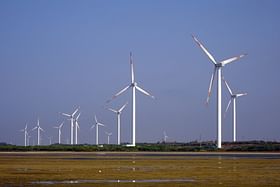India is set to strengthen wind turbine standards as the Ministry of New and Renewable Energy prepares to introduce a quality control order (QCO) soon.
These standards will focus on meeting the requirements for various components used in wind turbines, including gears and blades.
To address the issue of China’s product dumping in India, the government is increasingly utilising the QCO approach. This move comes as India’s trade deficit with China continues to widen, with China accounting for almost 40 per cent of the total trade deficit, reports Mint.
The government has planned to implement QCOs for various products across different sectors, ranging from textiles to wind power.
Under a QCO, manufacturers, importers, and distributors are prohibited from storing or selling a product without a standard mark, unless they possess a license from the Bureau of Indian Standards (BIS).
In addition to the QCO, the government is also developing an Indian Wind Turbine Certification Scheme (IWTCS). It is anticipated that the QCO will require mandatory certification under the proposed IWTCS, as per reports.
The certification scheme has been in development since 2018. Its purpose is to establish consolidated standards that combine global best practices with relevant national standards, technical regulations, and requirements set by the Central Electricity Authority (CEA), the electricity regulator.
According to U B Reddy, a member of the national council of the Indian Wind Power Association (IWPA), implementing a certification system would enable the creation of an Indian standard that aligns with the global standard for certification, known as IECRE.
“The IWTCS would create and Indian standard of global level and may help get Indian productions accepted globally also,” Reddy said, adding that new quality control measures including the planned QCO and the indigenous standards would benefit the domestic industry.
The Ministry of New and Renewable Energy reports that the wind power equipment manufacturing sector has achieved around 70-80 per cent indigenisation.
India is home to several major global players in this field, with over 14 firms operating as joint ventures or subsidiaries of foreign companies.
While the annual energy production capacity of domestic wind turbines is approximately 12,000 MW, certain components are still imported from countries such as China, Japan, South Korea, and Europe.
The government’s plan to establish stringent norms aligns with its intention to issue tenders for offshore wind energy projects.
Furthermore, it would also expedite India’s progress towards achieving net zero targets and establish the country as a prominent player in the renewable energy sector.


